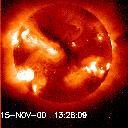

The gizmo in question, for this nugget, is referred to as a Charge-coupled device or, more typically, a CCD detector. In this nugget we'll explore how it is that CCDs work, how they age, what goes wrong with them, and specifically what's the current state of the union for the Yohkoh CCD.
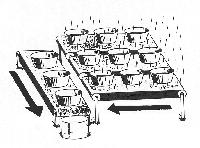
This bar napkin was stolen wholesale from one of the big CCD experts in the field, Jim Janesick of Pixelvision, Inc. The pixels are illustrated with analogous buckets, collecting rain (or, in reality, photons). What happens is photons land in each bucket, and knock loose electrons in the CCD via the Photoelectric Effect. Then we have to somehow corral all of these electrons and shuffle them off the CCD in a controlled fashion. Armed with our cattle prod, here's how we do it:
Another concern is the Van Allen Radiation Belts. These belts, located in rings around the North and South poles. Yohkoh doesn't pass through these belts, but other satellites, such as the Chandra X-Ray Observatory and the Transition Region and Coronal Explorer pass through them on a regular basis. Chandra initially had difficulties with the Van Allen belts as the instrument was typically bore-sighted right through these radiation zones, and the energetic protons were focussed directly onto the CCDs. The energy of these protons was sufficient to displace about 12 silicon atoms per incident proton! The charge-transfer efficiency (I'll describe this below) of some of the CCDs was weakened pretty significantly by this process until it was worked out what was going on. TRACE passes through the radiation belts 4 times every 90 minutes or so. The CCDs survive this just fine, but TRACE images incur a pretty heavy penalty during these passes.
0 22-DEC-91 21:21:05 QT/H Open /Al.1 Half Dark C 23 2668.0 512x512 1 12-SEP-00 17:32:02 QT/H Open /AlMg Half Dark C 23 2668.0 512x512What I've selected here are two random dark current images: one from shortly after launch, and one from a couple of months ago as of this writing. The resolution and exposure times are the same, and while the filters are different, that's OK since the shutter is closed during the exposure and there shouldn't be any light getting to the CCD. In both cases, the CCD temperature was -21 C. Without further ado, the images:
| 22-Dec-1991 | 12-Sep-2000 |
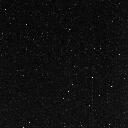 |
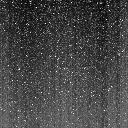 |
If one places any creedence in a statistical sample of two images, things have indeed changed in the intervening 9 years since launch. For a real study, I'd use the entire database, but for a short study like this, two images serve our purposes just fine. These images are displayed with the same scaling, so it's immediately apparent that the more recent dark image has greater dark current. We can also look for other things like hot pixels and streaks in the images. If the 1991 image were scaled more aggressively, we'd also see streaks in it as well. There are also streaks associated with hot pixels. The two kinds I can think of are:
Another thing we can note, especially in the 12-Sep-2000 image, is a "ramp" in the dark current. This is because we're still accumulating dark current as the image is being transferred off of the CCD. Thus, at the end of, say, a nominal 10-second exposure, we then have to shift the entire image off the bottom of the CCD. So the first few rows have comparatively little dark current, but the rows of pixels near the top of the image spend an additional 8 or so seconds waiting to be clocked off the CCD, and thus collect more spurious electrons. Hence: the dark current ramp.
So, that's some basic stuff we can garner from staring at the images. Let's look at the statistics now. First, a histogram of the CCD dark current for both frames:
| 22-Dec-1991 | 12-Sep-2000 |
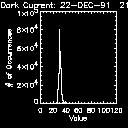 |
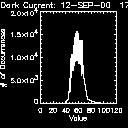 |
OK, now we're getting somewhere. It's apparent that the dark current has about doubled over time, and there's a lot more spread in it now. (I think this spread can partially be attributed to that "ramp" we discussed earlier.) There's also a bunch more hot pixels, so there's just a lot more of everything.
Finally, let's look at a slightly more complicated plot that tells all about CCDs:
| 22-Dec-1991 | 12-Sep-2000 |
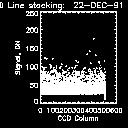 |
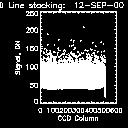 |
This plot is a standard tool that CCD folks use to evaluate devices, though normally this is done under much more controlled conditions using, say, an Iron 55 X-ray source. (Discussions of why that's cool is beyond the scope of this nugget, which is already beyond the scope of a normal SXT nugget!)
So what are we looking at? The X-axis is the column number across the chip. The Y-axis is recorded CCD signal. Then we plot the value of each pixel on the CCD: each column on this plot has 512 points plotted on it. We can see first-hand the distribution across the chip, and the distribution of pixels. So what can we see here?
First, the spread in dark current is evident. Also note the uneven baseline in signal in the 12-Sep-2000 baseline: humps in the dark current exist at rows 100 and 400, approximately. These very likely correspond approximately to the location of the solar limb on the CCD, and have impacted the dark current there. (I think.) Also note the relatively small dark current for a few pixels at the far right of both images: This is the charge that is stored up in the horizontal register when the image is collected. The spread in that distribution is the read noise for the CCD. It's increased over time. My back-of the envelope calculation gives a read noise in 1991 of about 3 DN. In 2000, I get a read noise of about 7.2 DN. (I got this by taking the standard deviation of rows 500-512. I'm not convinced I know what I'm talking about here.)
We've really only scratched the surface with this basic analysis, but
in the spirit of keeping this as simple as possible, this is a good stopping
point. While at first glance it seems alarming that the dark current has
increased so dramatically, it's important to realize that the dark current is
also very consistent from image to image, and thus dark current corrections
generally work extremely well even with a degraded CCD. It's even possible
to do science with a warm CCD, as we've previously discussed during a
CCD bake-out.
December 1, 2000
Brian Handy <handy@isass0.solar.isas.ac.jp>